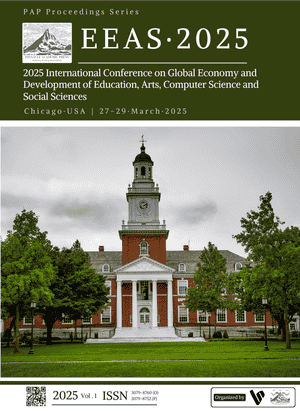Knowledge Mapping of Female Image Research from the Perspective of Journalism and Communication Studies
Keywords:
female image, media representation, feminist discourse, social media, content analysisAbstract
This study explores the development of research on female images within China’s media and communication fields from the mid-1990s to 2023. Originating from the second wave of the women's movement and influenced by foundational feminist media studies, the academic inquiry into female media representations has significantly expanded, particularly following landmark events like the Fourth World Conference on Women. Analyzing 510 scholarly papers from the China National Knowledge Infrastructure (CNKI), the research identifies a clear progression from initial critiques of stereotypical and superficial portrayals of women in television advertisements to a broader examination encompassing various media forms, including social media and reality television. Utilizing CiteSpace software for knowledge mapping and keyword co-occurrence analysis, the study categorizes the research into four primary areas: theoretical frameworks, micro-level case studies, macro-level media analyses, and comparative studies. Findings indicate a notable shift from traditional media platforms to digital and interactive media, with recent studies emphasizing the impact of technological advancements on the diversity and complexity of female representations. The research highlights the dynamic nature of female image studies in China, underscoring the critical role of media in shaping and reflecting gender relations. Future research directions call for expanded methodologies, including interactive text analysis and empirical testing, to further understand the nuanced portrayals of women in an increasingly digital and interconnected world.
References
1. T. Thornborrow, L. G. Boothroyd, and M. J. Tovee, “‘Thank God we are like this here’: A qualitative investigation of tele-visual media influence on women’s body image in an ethnically diverse rural Nicaraguan population,” Body Image, vol. 52, p. 101817, 2025, doi: 10.1016/j.bodyim.2024.101817.
2. X. Chen and G. Song, “Gender representation in translation: Examining the reshaping of a female child’s image in the English translation of the children’s novel Bronze and Sunflower,” Child. Lit. Educ., vol. 56, no. 1, pp. 51-68, 2025, doi: 10.1007/s10583-023-09539-7.
3. Y. Kim and S. Y. Kwon, “‘Keeping up with the Korean Yeojas’: the paradox of Korean women’s participation of aesthetic ex-ercise in contemporary Korea,” Sport Soc., vol. 28, no. 1, pp. 41-56, 2025, doi: 10.1080/17430437.2024.2341047.
4. C. Yanru, "From ideal women to women's ideal: Evolution of the female image in Chinese feature films, 1949–2000," Asian J. Women's Stud., vol. 14, no. 3, pp. 97–129, 2008, doi: 10.1080/12259276.2008.11666052.
5. K. M. Zosuls, C. F. Miller, D. N. Ruble, C. L. Martin, and R. A. Fabes, "Gender development research in sex roles: Historical trends and future directions," Sex Roles, vol. 64, pp. 826–842, 2011, doi: 10.1007/s11199-010-9902-3.
6. L. Karlsson, "Towards a language of sexual gray zones: Feminist collective knowledge building through autobiographical multimedia storytelling," Feminist Media Stud., vol. 19, no. 2, pp. 210–224, 2019, doi: 10.1080/14680777.2018.1467944.
7. W. Shi and S. D. Liu, “Middle-aged women’s tears: rethinking Chinese popular feminism through Sisters Who Make Waves,” Feminist Media Stud., vol. 25, no. 1, pp. 137-153, 2025, doi: 10.1080/14680777.2023.2271179.
8. G. C. Minikowski, D. F. Veiga, G. D. A. A. Felix, J. C. M. Pedroso, L. M. Ferreira, and M. S. Neto, “Genital self-image and body dysmorphic symptoms in patients undergoing central wedge or linear labiaplasty: a clinical trial,” Plast. Reconstr. Surg., vol. 155, no. 1, pp. 53e-65e, 2025, doi: 10.1097/PRS.0000000000011534.
9. M. Wheadon and N. Duval-Couetil, "The gendering of entrepreneurship on reality television," J. Small Bus. Manag., vol. 57, pp. 1676–1697, 2019, doi: 10.1111/jsbm.12443.
10. Y. Sun, C. Liang, and C. C. Chang, "Online social construction of Taiwan's rural image: Comparison between Taiwanese self-representation and Chinese perception," Tourism Manag., vol. 76, p. 103968, 2020, doi: 10.1016/j.tourman.2019.103968.
11. G. Hilson and Y. Hu, "Changing priorities, shifting narratives: remapping rural livelihoods in Africa's artisanal and small-scale mining sector," J. Rural Stud., vol. 92, pp. 93–108, 2022, doi: 10.1016/j.jrurstud.2022.03.010.
12. Q. Yao, S. Deng, L. Liu, and Y. Luo, “Mediating effects of psychological resilience on the relationship between social support and body image dissatisfaction among patients with primary brain tumors in China,” Psychol. Health Med., pp. 1-13, 2025, doi: 10.1080/13548506.2024.2447007.
Downloads
Published
Issue
Section
License
Copyright (c) 2025 Yunxin Zhang (Author)

This work is licensed under a Creative Commons Attribution 4.0 International License.



